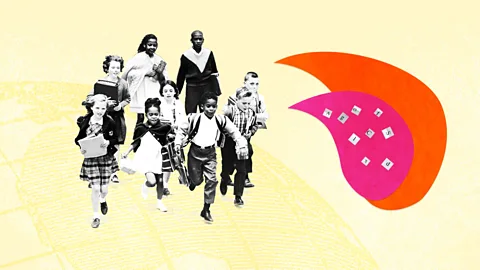
Isabelle Gerretsen, who grew up speaking Dutch and English, investigates the latest science on helping children become fluent in two or more languages – including advice for parents who speak one language but would like their children to be multilingual.
When I was seven years old, I went away to a school camp for the first time. While there, we were all encouraged to write letters back home. I wrote a detailed letter in English to my mum, telling her about all the activities we’d been doing. I then translated the letter word-for-word into Dutch for my dad, a native Dutch speaker. This story still makes my dad, who is fluent in both Dutch and English, laugh.
My parents raised my sisters and I bilingually from birth. They sought advice and were told to only speak their respective languages to us. They stuck to this so strictly that for an embarrassingly long time we did not realise that they both spoke Dutch and English fluently. Nowadays, we speak a Dutch-English blend at home, often switching between languages mid-sentence. However, there is still a common idea that the model my parents followed is the best guarantee of raising truly bilingual children: start at birth, with each parent strictly sticking to their native language. Among language experts, it’s known as the OPOL strategy, short for “one parent, one language“. But is that really the only way of achieving bilingualism? And do you need to already have two languages in your life when you start the process, or can you raise a bilingual child even if you and others around you only speak one language?

There are actually many different ways to expose your child to two languages and no single approach has been found to be the best one, says Viorica Marian, author of the Power of Language and professor of communication sciences and disorders at Northwestern University in Illinois, in the US.
The approach my parents took – of only ever speaking to us in their respective languages – can work well for parents who speak different languages, Marian says. Other parents may choose to speak just one language at home, often a minority language, as they know their child will be exposed to the other language at school. (“Minority” in this context just means it’s less widely spoken or officially entrenched than the other language, in any given society or education system: in the US and UK, for example, Spanish would be a minority language, and English, the majority language.) Over time, families may need to make a special effort to keep the minority language in use: it is generally more at risk of fading away in children’s lives as their interactions outside the home increase, and the majority language becomes more dominant.
“A different strategy could be to speak to your child in a different language each day of the week,” says Marian. This is sometimes referred to as the “time and place” strategy among researchers and bilingual families, with each language associated with a specific time or location – the whole family might be speaking one language on weekends, or over shared meals, for example, and another language during the week, or when out and about.
The most effective strategies are those that can be incorporated consistently and long-term. “Ultimately, the strategy that will be successful is the one that works for your particular family and makes the experience enjoyable and not a chore,” she says.
The successful strategy is the one that makes the experience enjoyable and not a chore – Viorica Marian
Krupa Padhy, a radio presenter for the BBC World Service, is raising her two children, aged seven and nine, bilingually. Padhy was raised in a Gujarati-speaking household in the UK, while her husband speaks Hindi. They have decided to speak English and Hindi at home. “Hindi is more useful for them as it’s understood by the entire Asian subcontinent,” she says.
“We’ve got no coherent strategy,” says Padhy. Her main goal is to teach her children conversational Hindi so that they can introduce themselves, tell people how old they are and how many siblings they have. Learning sentence structures off by heart and repetition have really helped, says Padhy.
The family visits India every 18 months and Padhy says it is “so empowering for my kids to access that culture authentically”.
“It’s really nice that they are able to engage and understand what’s happening around them,” she adds.
Learning Hindi is also allowing the family to enjoy Indian culture at home. “Every Saturday night is Hindi movie night,” says Padhy. “The kids love watching Hindi movies. It’s really helping.”
LET’S TALK
Let’s Talk is a language series across BBC.com, exploring the ancient roots of alphabets, jargon-busting the modern boardroom, and seeking to understand why we speak the way we do. Browse the whole series here.
A perfect window?
Research suggests that it’s a good idea to introduce the second language as early as possible, as children learn the sound and rhythm of their birth language, known as its phonology, at a very young age. According to a 2013 study, babies start learning language before they are even born. The study found that in the final 10 weeks of pregnancy foetuses are listening to their mothers talk and that they can demonstrate what they’ve heard once born.
Forty American and Swedish infants, about 30 hours old, were exposed to vowel sounds in their mother tongue and foreign language. Their response was measured by how long they sucked on a pacifier connected to a computer. Both the American and Swedish babies sucked longer for the foreign language than they did for their mother tongue. Longer sucking for unfamiliar sounds was evidence of learning and shows that babies are able to differentiate between languages at birth, the researchers said.
That doesn’t mean it’s ever too late to add a second language: older children and even adults can still learn other languages, and there can be other benefits such as the joy of connecting with one’s heritage. But younger children may find it easier to pick up a native-like accent, experts say. (Read BBC Future’s article on reclaiming lost family languages.)
“The earlier you start, the better,” says Sirada Rochanavibhata, assistant professor in the department of child and adolescent development at San Francisco State University, California. “An advantage of learning a language early is that it is easier to achieve native-like proficiency.”
“During the first six months, infants can discriminate between speech sounds of all languages,” says Rochanavibhata. After this, children lose the ability to tell apart sounds that are not used in their native language or languages they are exposed to.

“In English, the ‘r’ and ‘l’ sounds are distinct and can change the meaning of a word (for example, ‘read’ and ‘lead’), whereas in Japanese, the ‘r’ and ‘l’ sounds are combined into a single category (Japanese ‘r’). Japanese speakers learning English may find the English r–l distinction difficult,” explains Rochanavibhata. This process is known as perceptual narrowing.
The age at which a child acquires a second language can therefore impact their ability to hear and produce speech sounds of that language, she says.
However, if you or your family have missed that window, there are still other opportunities, Rochanavibhata and other researchers stress. “Adults can still become fluent in additional languages, but the process may require more effort and different approaches,” adds Rochanavibhata.
Motivating older children
There can also be practical advantages to setting a solid bilingual foundation in the early years, researchers say. Starting at a young age allows children to “be fully immersed” in both languages, says Antonella Sorace, professor of developmental linguistics and founder of the Bilingualism Matters programme, a research and information centre at the University of Edinburgh, in the UK, that promotes bilingualism and language learning. Young children don’t have other commitments, such as school and an independent social life, she says.
It’s not just starting early that can make a positive difference, however. The other challenge is to keep the second language going, especially once children become more independent.
To achieve this, it’s important that children are motivated and encouraged to speak multiple languages, says Sorace. “This is not always easy because children don’t like feeling different. We hear from many migrant children that they don’t want to speak their home language anymore, because that’s what marks them out as different.”
One way of encouraging children is by creating a “mini community” where they can regularly interact with peers who speak their language, she says. “This can be incredibly motivating.”
It is important that children hear both their languages frequently and spoken by a variety of native speakers, says Marian. “Having regular interactions with many different speakers of the two languages can help boost bilingual proficiency, as children are exposed to more diversity,” she says.
One way of encouraging children’s bilingualism is by creating a “mini community” with peers who speak their language – Antonella Sorace
Environment plays an important role and constant exposure to both languages is key, agrees Elisabet García González, research fellow at the Center for Multilingualism in Society Across the Lifespan at the University of Oslo in Norway. If a child born into a bilingual family stops using one of their languages when they are eight, that is going to have a significant impact on their bilingualism, she says. “Language is something that changes across the lifespan.”
Monolingual parents, bilingual children?
Even if parents aren’t fully multilingual themselves, they can still invite a mix of languages into the home, says Sorace. For example, a parent could start learning a second language and then occasionally use that language with their child, she says. This exposes the child to words or phrases in another language and has benefits even if the speaker is not perfectly proficient. “Perfection doesn’t exist in languages,” says Sorace.
In Sorace’s view, parents’ confidence to speak a mix of languages at home is more important than their linguistic ability. “If they are confident, the child will hear enough of that language and learn it,” she says. Discovering and using new languages then becomes a family project, with everyone getting the benefits, including the parents: “We tell parents to seize this wonderful opportunity [of enjoying another language with their child],” she says. “The aim is not for you to become perfect in the language, but to learn more and to be able to communicate with your child.”
Padhy says her Hindi has improved since she started speaking it to her children. “I’m learning loads,” says Padhy. “I’m speaking better Hindi than I ever have before because I’m teaching them.”
There may also be other opportunities for monolingual parents to encourage bilingualism in the family, the researchers say. Marian suggests a range of options, for example, choosing a bilingual babysitter or nursery or signing their children up for language lessons at a community centre or after-school club where they hear multiple languages.
“As the child grows older, having them participate in exchange programmes and study abroad programmes, take foreign language courses, and travel to countries where the other language is spoken will further support and advance language learning,” she says.
Are bilingual brains different?
For those who do make the effort to acquire a second language – whether as children, or later on as adults and parents – the process can yield brain-boosting benefits, regardless of the level of fluency achieved.
Learning multiple languages leads to increased grey matter volume in the prefrontal cortex, the front part of the brain which is important for high-level thinking, such as decision-making and problem-solving, says Ashley Chung-Fat-Yim, research assistant professor in bilingualism and psycholinguistics at Illinois’ Northwestern University. “We also see improvements in white matter in the same brain regions.”
While grey matter is where important information processing happens, white matter carries messages between brain regions, explains Chung-Fat-Yim. “Think of grey matter as subway stations and white matter as subway tunnels connecting different subway stations to each other. Multilingualism helps to keep the structure of the ‘subway tunnels’ intact for faster and more efficient signal transmission. In other words, communication between brain regions can happen more optimally,” says Chung-Fat-Yim.
Speaking more than one language, and the mental exercise this involves, may also build the brain’s resilience and help delay the onset of symptoms of Alzheimer’s disease, research suggests. According to a 2020 review of more than 20 existing studies, being bilingual can delay Alzheimer’s symptoms by as much as five years. Bilingualism does not prevent the occurrence of Alzheimer’s but rather helps ward off symptoms for longer, the researchers concluded. They described bilingualism as a form of cognitive reserve that strengthens and reorganises the brain’s circuits.
“Just like exercising strengthens your muscles, multilingualism strengthens your brain to maintain cognitive functioning,” says Chung-Fat-Yim. (Read more about how our brains cope with speaking more than one language.)
There are also cognitive benefits to be gained earlier in life, research suggests. According to one study, bilingual children may, for example, be better at switching between tasks than monolingual speakers. More than 100 children were asked to sort images of either colours or animals on a computer. The children who spoke a second language (French, Spanish or Chinese) were better at switching between the two categories, which indicates their multitasking ability, the researchers concluded.
“Learning another language is always a good thing,” says Sorace. “It enriches your world from a cultural point of view and benefits the brain.”








